Genome-Wide Analysis of VILLIN Gene Family Associated with Stress Responses in Cotton (Gossypium spp.)
Abstract
:1. Introduction
2. Materials and Methods
2.1. Sequence Retrieval and Identification of Villin Gene Family
2.2. Analysis of Protein Physiochemical Properties, Amino Acid Alignment, and Phylogenetic Investigation
2.3. Analysis of Gene Structure, Identification of Conserved Motifs, and Conducting Conserved Domain Analysis
2.4. Collinearity and Chromosomal Location Analysis of GhVLN Genes
2.5. GhVLNs Structure Prediction and Protein–Protein Interation
2.6. Measurement of Evolutionary Selection Pressure and Cis-Element Analysis
2.7. Expression Patterns of GhVLNs in Different Tissues and Stress Conditions
3. Results
3.1. Sequence Retrieval of VLN Gene and Characterization of GhVLNs
3.2. Phylogenetic Analysis of Gossypium Species and Their Orthologs from Other Model Species
3.3. Gene Structure Analysis of GhVLNs and the Conserved Domain and Motif Analysis of GhVLNs
3.4. Collinearity and Chromosomal Location Analysis of GhVLNs Gene
3.5. Three-Dimensional Structure Prediction and Protein–Protein Interaction Network
3.6. Analysis of Evolutionary Selection Pressure
3.7. Cis-Element and Expression Analysis of GhVLNs
3.8. Gene-Expression Pattern Analysis in Different Organs of GhVLNs
4. Discussion
5. Conclusions
Supplementary Materials
Author Contributions
Funding
Institutional Review Board Statement
Informed Consent Statement
Data Availability Statement
Acknowledgments
Conflicts of Interest
References
- Yuan, G.; Gao, H.; Yang, T. Exploring the Role of the Plant Actin Cytoskeleton: From Signaling to Cellular Functions. Int. J. Mol. Sci. 2023, 24, 15480. [Google Scholar] [CrossRef]
- Pollard, T.D. Actin and Actin-Binding Proteins. Cold Spring Harb. Perspect. Biol. 2016, 8, a018226. [Google Scholar] [CrossRef]
- Pandey, D.K.; Chaudhary, B. Transcriptional Loss of Domestication-Driven Cytoskeletal GhPRF1 Gene Causes Defective Floral and Fiber Development in Cotton (Gossypium). Plant Mol. Biol. 2021, 107, 519–532. [Google Scholar] [CrossRef]
- Qian, D.; Zhang, Z.; He, J.; Zhang, P.; Ou, X.; Li, T.; Niu, L.; Nan, Q.; Niu, Y.; He, W.; et al. Arabidopsis ADF5 Promotes Stomatal Closure by Regulating Actin Cytoskeleton Remodeling in Response to ABA and Drought Stress. J. Exp. Bot. 2019, 70, 435–446. [Google Scholar] [CrossRef] [PubMed]
- Zhang, Y.; Xiao, Y.; Du, F.; Cao, L.; Dong, H.; Ren, H. Arabidopsis VILLIN4 Is Involved in Root Hair Growth through Regulating Actin Organization in a Ca2+-Dependent Manner. New Phytol. 2011, 190, 667–682. [Google Scholar] [CrossRef] [PubMed]
- Christensen, H.E.M.; Ramachandran, S.; Tan, C.; Surana, U.; Dong, C.; Chua, N. Arabidopsis Profilins Are Functionally Similar to Yeast Profilins: Identification of a Vascular Bundle-specific Profilin and a Pollen-specific Profilin. Plant J. 1996, 10, 269–279. [Google Scholar] [CrossRef] [PubMed]
- Pandey, D.K.; Chaudhary, B. Evolutionary Expansion and Structural Functionalism of the Ancient Family of Profilin Proteins. Gene 2017, 626, 70–86. [Google Scholar] [CrossRef]
- Pandey, D.K.; Chaudhary, B. Evolution of Functional Diversity Among Actin-Binding Profilin Genes in Land Plants. Front. Cell Dev. Biol. 2020, 8, 588689. [Google Scholar] [CrossRef]
- Ramachandran, S.; Christensen, H.E.M.; Ishimaru, Y.; Dong, C.-H.; Chao-Ming, W.; Cleary, A.L.; Chua, N.-H. Profilin Plays a Role in Cell Elongation, Cell Shape Maintenance, and Flowering in Arabidopsis. Plant Physiol. 2000, 124, 1637–1647. [Google Scholar] [CrossRef]
- Müssar, K.J.; Kandasamy, M.K.; McKinney, E.C.; Meagher, R.B. Arabidopsis Plants Deficient in Constitutive Class Profilins Reveal Independent and Quantitative Genetic Effects. BMC Plant Biol. 2015, 15, 177. [Google Scholar] [CrossRef]
- Pandey, D.K.; Chaudhary, B. Domestication-Driven Gossypium Profilin 1 (GhPRF1) Gene Transduces Early Flowering Phenotype in Tobacco by Spatial Alteration of Apical/Floral-Meristem Related Gene Expression. BMC Plant Biol. 2016, 16, 112. [Google Scholar] [CrossRef] [PubMed]
- Ding, X.; Zhang, S.; Liu, J.; Liu, S.; Su, H. Arabidopsis FIM4 and FIM5 Regulates the Growth of Root Hairs in an Auxin-Insensitive Way. Plant Signal. Behav. 2018, 13, e1473667. [Google Scholar] [CrossRef] [PubMed]
- Hesterberg, L.K.; Weber, K. Demonstration of Three Distinct Calcium-Binding Sites in Villin, a Modulator of Actin Assembly. J. Biol. Chem. 1983, 258, 365–369. [Google Scholar] [CrossRef] [PubMed]
- Kumar, N.; Tomar, A.; Parrill, A.L.; Khurana, S. Functional Dissection and Molecular Characterization of Calcium-Sensitive Actin-Capping and Actin-Depolymerizing Sites in Villin. J. Biol. Chem. 2004, 279, 45036–45046. [Google Scholar] [CrossRef]
- Zhai, L.; Zhao, P.; Panebra, A.; Guerrerio, A.L.; Khurana, S. Tyrosine Phosphorylation of Villin Regulates the Organization of the Actin Cytoskeleton. J. Biol. Chem. 2001, 276, 36163–36167. [Google Scholar] [CrossRef]
- Hampton, C.M.; Liu, J.; Taylor, D.W.; DeRosier, D.J.; Taylor, K.A. The 3D Structure of Villin as an Unusual F-Actin Crosslinker. Structure 2008, 16, 1882–1891. [Google Scholar] [CrossRef] [PubMed]
- Thomas, C.; Tholl, S.; Moes, D.; Dieterle, M.; Papuga, J.; Moreau, F.; Steinmetz, A. Actin Bundling in Plants. Cell Motil. 2009, 66, 940–957. [Google Scholar] [CrossRef]
- Vardar, D.; Buckley, D.A.; Frank, B.S.; McKnight, C.J. NMR Structure of an F-Actin-Binding “Headpiece” Motif from Villin. J. Mol. Biol. 1999, 294, 1299–1310. [Google Scholar] [CrossRef]
- Dos Remedios, C.G.; Chhabra, D.; Kekic, M.; Dedova, I.V.; Tsubakihara, M.; Berry, D.A.; Nosworthy, N.J. Actin Binding Proteins: Regulation of Cytoskeletal Microfilaments. Physiol. Rev. 2003, 83, 433–473. [Google Scholar] [CrossRef]
- Huang, S.; Qu, X.; Zhang, R. Plant Villins: Versatile Actin Regulatory Proteins. J. Integr. Plant Biol. 2015, 57, 40–49. [Google Scholar] [CrossRef]
- Su, H.; Wang, T.; Dong, H.; Ren, H. The Villin/Gelsolin/Fragmin Superfamily Proteins in Plants. J. Integr. Plant Biol. 2007, 49, 1183–1191. [Google Scholar] [CrossRef]
- Tominaga, M.; Yokota, E.; Vidali, L.; Sonobe, S.; Hepler, P.K.; Shimmen, T. The Role of Plant Villin in the Organization of the Actin Cytoskeleton, Cytoplasmic Streaming and the Architecture of the Transvacuolar Strand in Root Hair Cells of Hydrocharis. Planta 2000, 210, 836–843. [Google Scholar] [CrossRef] [PubMed]
- Vidali, L.; Yokota, E.; Cheung, A.Y.; Shimmen, T.; Hepler, P.K. The 135 kDa Actin-Bundling Protein fromLilium Longiflorum Pollen Is the Plant Homologue of Villin. Protoplasma 1999, 209, 283–291. [Google Scholar] [CrossRef]
- Yokota, E.; Vidali, L.; Tominaga, M.; Tahara, H.; Orii, H.; Morizane, Y.; Hepler, P.K.; Shimmen, T. Plant 115-kDa Actin-Filament Bundling Protein, P-115-ABP, Is a Homologue of Plant Villin and Is Widely Distributed in Cells. Plant Cell Physiol. 2003, 44, 1088–1099. [Google Scholar] [CrossRef] [PubMed]
- Yokota, E.; Shimmen, T. The 135-kDa Actin-Bundling Protein from Lily Pollen Tubes Arranges F-Actin into Bundles with Uniform Polarity. Planta 1999, 209, 264–266. [Google Scholar] [CrossRef] [PubMed]
- Khurana, S. Role of Actin Cytoskeleton in Regulation of Ion Transport: Examples from Epithelial Cells. J. Membr. Biol. 2000, 178, 73–87. [Google Scholar] [CrossRef]
- Lv, F.; Han, M.; Ge, D.; Dong, H.; Zhang, X.; Li, L.; Zhang, P.; Zhang, Z.; Sun, J.; Liu, K.; et al. GhVLN4 Is Involved in Cell Elongation via Regulation of Actin Organization. Planta 2017, 246, 687–700. [Google Scholar] [CrossRef]
- Pina, C.; Pinto, F.; Feijó, J.A.; Becker, J.D. Gene Family Analysis of the Arabidopsis Pollen Transcriptome Reveals Biological Implications for Cell Growth, Division Control, and Gene Expression Regulation. Plant Physiol. 2005, 138, 744–756. [Google Scholar] [CrossRef]
- Staiger, C.J.; Hussey, P.J. Actin and Actin-Modulating Proteins. In Annual Plant Reviews Online; Roberts, J.A., Ed.; Wiley: Hoboken, NJ, USA, 2018; pp. 32–80. ISBN 978-1-119-31299-4. [Google Scholar]
- Wang, X.; Bi, S.; Wang, L.; Li, H.; Gao, B.; Huang, S.; Qu, X.; Cheng, J.; Wang, S.; Liu, C.; et al. GLABRA2 Regulates Actin Bundling Protein VILLIN1 in Root Hair Growth in Response to Osmotic Stress. Plant Physiol. 2020, 184, 176–193. [Google Scholar] [CrossRef]
- Bao, C.; Wang, J.; Zhang, R.; Zhang, B.; Zhang, H.; Zhou, Y.; Huang, S. Arabidopsis VILLIN2 and VILLIN3 Act Redundantly in Sclerenchyma Development via Bundling of Actin Filaments. Plant J. 2012, 71, 962–975. [Google Scholar] [CrossRef]
- Van Der Honing, H.S.; Kieft, H.; Emons, A.M.C.; Ketelaar, T. Arabidopsis VILLIN2 and VILLIN3 Are Required for the Generation of Thick Actin Filament Bundles and for Directional Organ Growth. Plant Physiol. 2012, 158, 1426–1438. [Google Scholar] [CrossRef]
- Zhang, H.; Qu, X.; Bao, C.; Khurana, P.; Wang, Q.; Xie, Y.; Zheng, Y.; Chen, N.; Blanchoin, L.; Staiger, C.J.; et al. Arabidopsis VILLIN5, an Actin Filament Bundling and Severing Protein, Is Necessary for Normal Pollen Tube Growth. Plant Cell 2010, 22, 2749–2767. [Google Scholar] [CrossRef]
- Raghavendra, K.P.; Das, J.; Kumar, R.; Gawande, S.P.; Santosh, H.B.; Sheeba, J.A.; Kranthi, S.; Kranthi, K.R.; Waghmare, V.N. Genome-Wide Identification and Expression Analysis of the Plant Specific LIM Genes in Gossypium Arboreum under Phytohormone, Salt and Pathogen Stress. Sci. Rep. 2021, 11, 9177. [Google Scholar] [CrossRef]
- Zhao, J.; Wang, P.; Gao, W.; Long, Y.; Wang, Y.; Geng, S.; Su, X.; Jiao, Y.; Chen, Q.; Qu, Y. Genome-Wide Identification of the DUF668 Gene Family in Cotton and Expression Profiling Analysis of GhDUF668 in Gossypium Hirsutum under Adverse Stress. BMC Genom. 2021, 22, 395. [Google Scholar] [CrossRef]
- Mistry, J.; Chuguransky, S.; Williams, L.; Qureshi, M.; Salazar, G.A.; Sonnhammer, E.L.L.; Tosatto, S.C.E.; Paladin, L.; Raj, S.; Richardson, L.J.; et al. Pfam: The Protein Families Database in 2021. Nucleic Acids Res. 2021, 49, D412–D419. [Google Scholar] [CrossRef] [PubMed]
- Sato, S. Structural Analysis of Arabidopsis Thaliana Chromosome 5. X. Sequence Features of the Regions of 3,076,755 Bp Covered by Sixty P1 and TAC Clones. DNA Res. 2000, 7, 31–63. [Google Scholar] [CrossRef] [PubMed]
- Goodstein, D.M.; Shu, S.; Howson, R.; Neupane, R.; Hayes, R.D.; Fazo, J.; Mitros, T.; Dirks, W.; Hellsten, U.; Putnam, N.; et al. Phytozome: A Comparative Platform for Green Plant Genomics. Nucleic Acids Res. 2012, 40, D1178–D1186. [Google Scholar] [CrossRef] [PubMed]
- Yang, M.; Derbyshire, M.K.; Yamashita, R.A.; Marchler-Bauer, A. NCBI’s Conserved Domain Database and Tools for Protein Domain Analysis. Curr. Protoc. Bioinform. 2020, 69, e90. [Google Scholar] [CrossRef]
- Letunic, I.; Khedkar, S.; Bork, P. SMART: Recent Updates, New Developments and Status in 2020. Nucleic Acids Res. 2021, 49, D458–D460. [Google Scholar] [CrossRef] [PubMed]
- Gasteiger, E.; Hoogland, C.; Gattiker, A.; Duvaud, S.; Wilkins, M.R.; Appel, R.D.; Bairoch, A. Protein Identification and Analysis Tools on the ExPASy Server. In The Proteomics Protocols Handbook; Walker, J.M., Ed.; Humana Press: Totowa, NJ, USA, 2005; pp. 571–607. ISBN 978-1-58829-343-5. [Google Scholar]
- Pierleoni, A.; Martelli, P.L.; Fariselli, P.; Casadio, R. BaCelLo: A Balanced Subcellular Localization Predictor. Bioinformatics 2006, 22, e408–e416. [Google Scholar] [CrossRef] [PubMed]
- Liu, M.; Li, C.; Li, Y.; An, Y.; Ruan, X.; Guo, Y.; Dong, X.; Ruan, Y. Genome-Wide Identification and Characterization of the VQ Motif-Containing Gene Family Based on Their Evolution and Expression Analysis under Abiotic Stress and Hormone Treatments in Foxtail Millet (Setaria Italica L.). Genes 2023, 14, 1032. [Google Scholar] [CrossRef]
- Tamura, K.; Stecher, G.; Kumar, S. MEGA11: Molecular Evolutionary Genetics Analysis Version 11. Mol. Biol. Evol. 2021, 38, 3022–3027. [Google Scholar] [CrossRef] [PubMed]
- Letunic, I.; Bork, P. Interactive Tree Of Life (iTOL) v5: An Online Tool for Phylogenetic Tree Display and Annotation. Nucleic Acids Res. 2021, 49, W293–W296. [Google Scholar] [CrossRef] [PubMed]
- Hu, B.; Jin, J.; Guo, A.-Y.; Zhang, H.; Luo, J.; Gao, G. GSDS 2.0: An Upgraded Gene Feature Visualization Server. Bioinformatics 2015, 31, 1296–1297. [Google Scholar] [CrossRef]
- Bailey, T.L.; Johnson, J.; Grant, C.E.; Noble, W.S. The MEME Suite. Nucleic Acids Res. 2015, 43, W39–W49. [Google Scholar] [CrossRef]
- Chao, J.; Li, Z.; Sun, Y.; Aluko, O.O.; Wu, X.; Wang, Q.; Liu, G. MG2C: A User-Friendly Online Tool for Drawing Genetic Maps. Mol. Hortic. 2021, 1, 16. [Google Scholar] [CrossRef] [PubMed]
- Waterhouse, A.; Bertoni, M.; Bienert, S.; Studer, G.; Tauriello, G.; Gumienny, R.; Heer, F.T.; de Beer, T.A.P.; Rempfer, C.; Bordoli, L.; et al. SWISS-MODEL: Homology Modelling of Protein Structures and Complexes. Nucleic Acids Res. 2018, 46, W296–W303. [Google Scholar] [CrossRef]
- Szklarczyk, D.; Gable, A.L.; Nastou, K.C.; Lyon, D.; Kirsch, R.; Pyysalo, S.; Doncheva, N.T.; Legeay, M.; Fang, T.; Bork, P.; et al. The STRING Database in 2021: Customizable Protein–Protein Networks, and Functional Characterization of User-Uploaded Gene/Measurement Sets. Nucleic Acids Res. 2021, 49, D605–D612. [Google Scholar] [CrossRef]
- Zhang, J.; Li, Y.; Liu, B.; Wang, L.; Zhang, L.; Hu, J.; Chen, J.; Zheng, H.; Lu, M. Characterization of the Populus Rab Family Genes and the Function of PtRabE1b in Salt Tolerance. BMC Plant Biol. 2018, 18, 124. [Google Scholar] [CrossRef]
- Zhang, Z.; Li, J.; Zhao, X.-Q.; Wang, J.; Wong, G.K.-S.; Yu, J. KaKs_Calculator: Calculating Ka and Ks Through Model Selection and Model Averaging. Genom. Proteom. Bioinform. 2006, 4, 259–263. [Google Scholar] [CrossRef]
- Lescot, M. PlantCARE, a Database of Plant Cis-Acting Regulatory Elements and a Portal to Tools for in Silico Analysis of Promoter Sequences. Nucleic Acids Res. 2002, 30, 325–327. [Google Scholar] [CrossRef]
- Khurana, S.; George, S.P. Regulation of Cell Structure and Function by Actin-Binding Proteins: Villin’s Perspective. FEBS Lett. 2008, 582, 2128–2139. [Google Scholar] [CrossRef]
- Khurana, P.; Henty, J.L.; Huang, S.; Staiger, A.M.; Blanchoin, L.; Staiger, C.J. Arabidopsis VILLIN1 and VILLIN3 Have Overlapping and Distinct Activities in Actin Bundle Formation and Turnover. Plant Cell 2010, 22, 2727–2748. [Google Scholar] [CrossRef] [PubMed]
- Lv, F.; Wang, S.; Tian, R.; Wang, P.; Liu, K. Villin Family Members Associated with Multiple Stress Responses in Cotton. Phyton-Int. J. Exp. Bot. 2021, 90, 1645–1660. [Google Scholar] [CrossRef]
- Zhou, Y.; He, L.; Zhou, S.; Wu, Q.; Zhou, X.; Mao, Y.; Zhao, B.; Wang, D.; Zhao, W.; Wang, R.; et al. Genome-Wide Identification and Expression Analysis of the VILLIN Gene Family in Soybean. Plants 2023, 12, 2101. [Google Scholar] [CrossRef] [PubMed]
- Biłas, R.; Szafran, K.; Hnatuszko-Konka, K.; Kononowicz, A.K. Cis-Regulatory Elements Used to Control Gene Expression in Plants. Plant Cell Tissue Organ Cult. PCTOC 2016, 127, 269–287. [Google Scholar] [CrossRef]
- Klahre, U.; Friederich, E.; Kost, B.; Louvard, D.; Chua, N.-H. Villin-Like Actin-Binding Proteins Are Expressed Ubiquitously in Arabidopsis. Plant Physiol. 2000, 122, 35–48. [Google Scholar] [CrossRef] [PubMed]
- Ge, D.; Pan, T.; Zhang, P.; Wang, L.; Zhang, J.; Zhang, Z.; Dong, H.; Sun, J.; Liu, K.; Lv, F. GhVLN4 Is Involved in Multiple Stress Responses and Required for Resistance to Verticillium Wilt. Plant Sci. 2021, 302, 110629. [Google Scholar] [CrossRef]
- Bi, S.; Li, M.; Liu, C.; Liu, X.; Cheng, J.; Wang, L.; Wang, J.; Lv, Y.; He, M.; Cheng, X.; et al. Actin Depolymerizing Factor ADF7 Inhibits Actin Bundling Protein VILLIN1 to Regulate Root Hair Formation in Response to Osmotic Stress in Arabidopsis. PLoS Genet. 2022, 18, e1010338. [Google Scholar] [CrossRef]
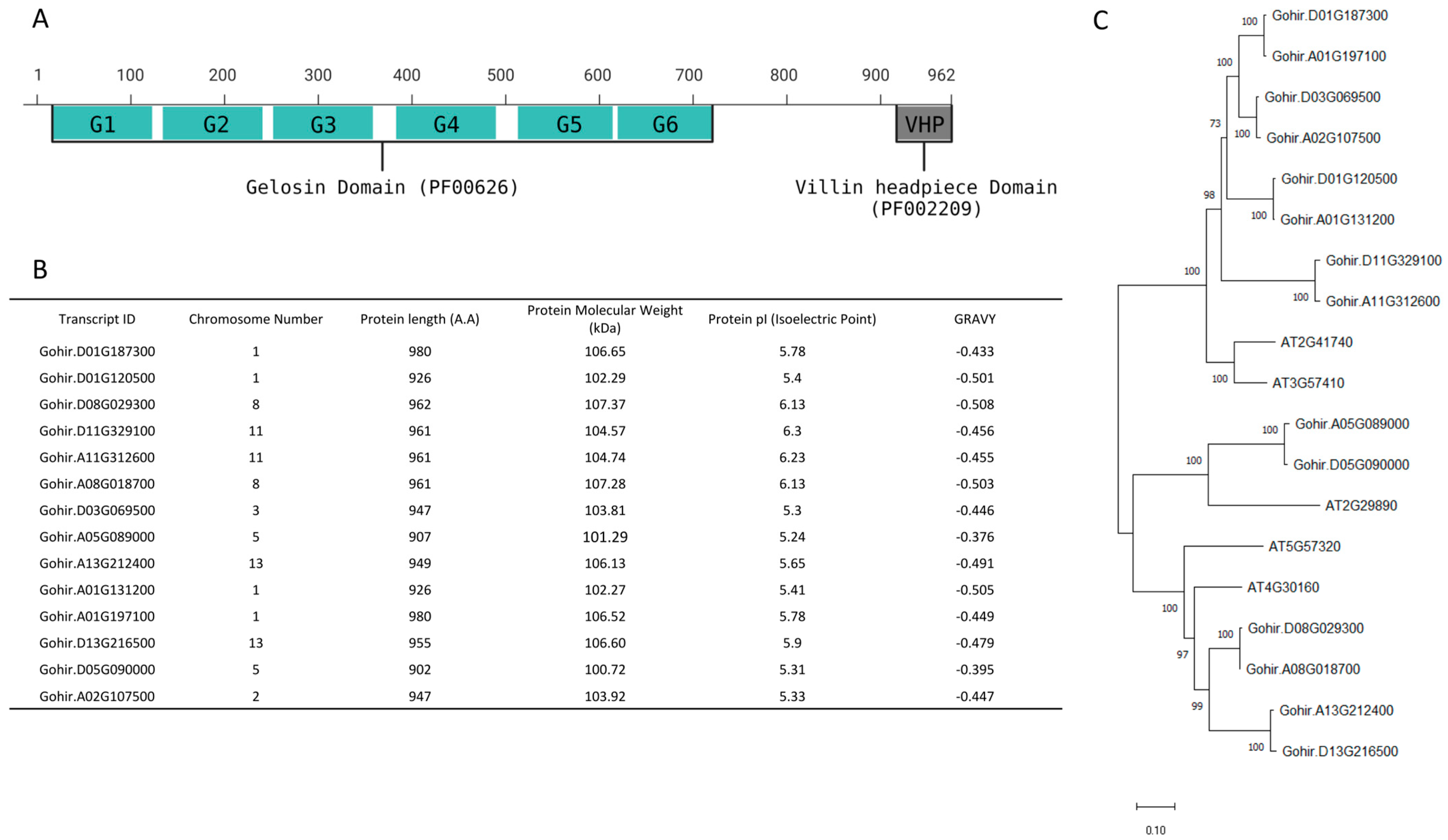
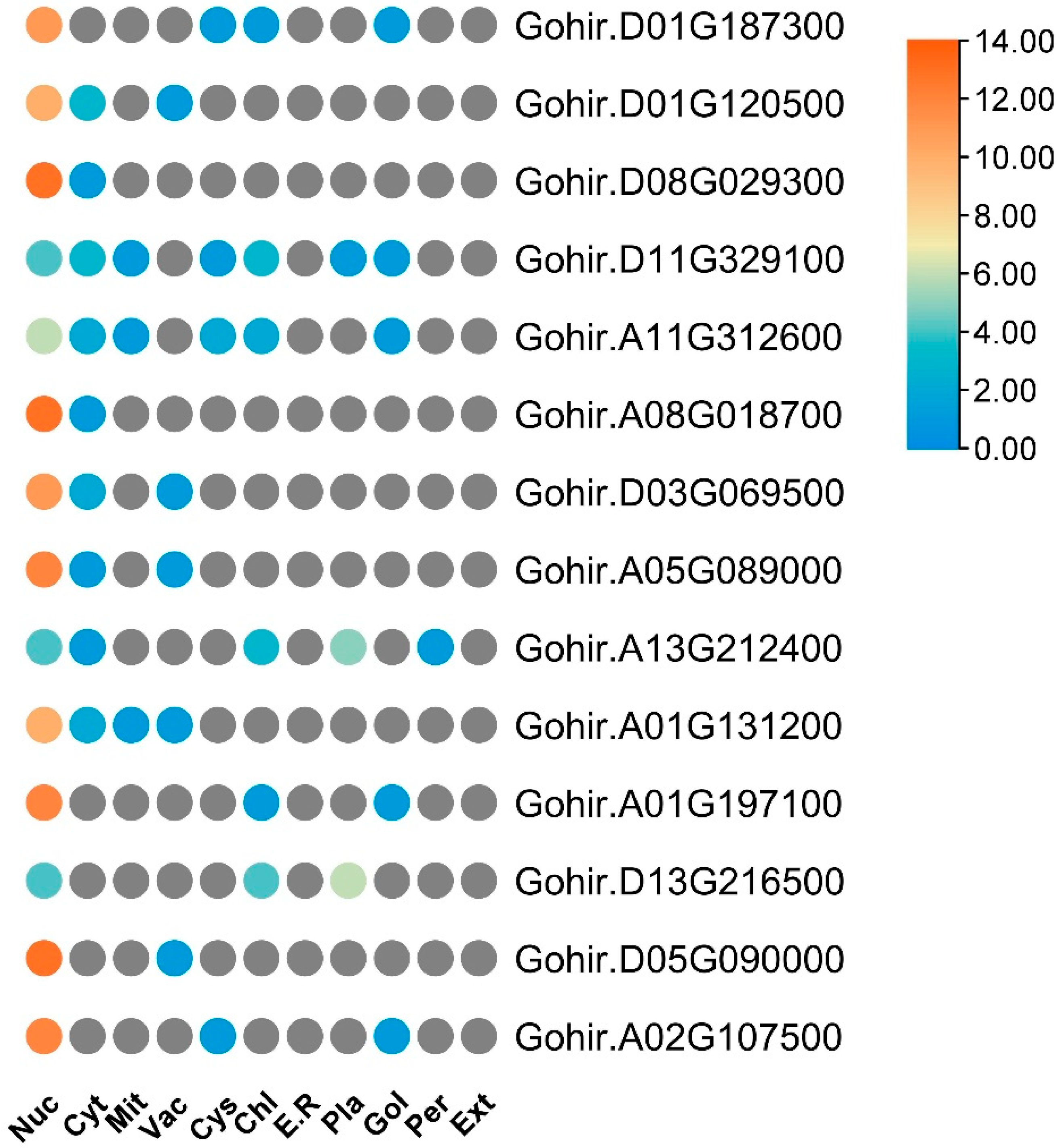

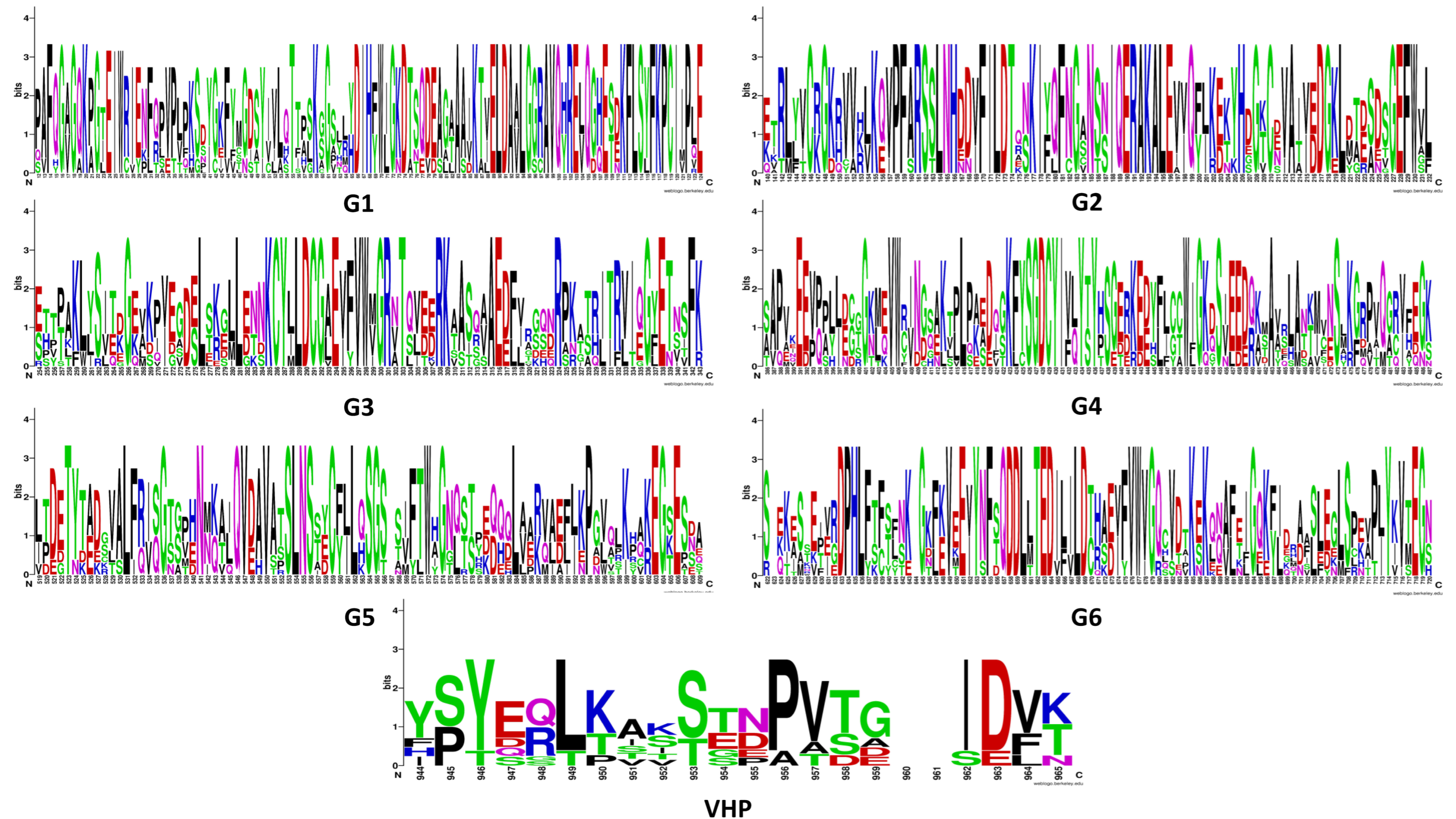
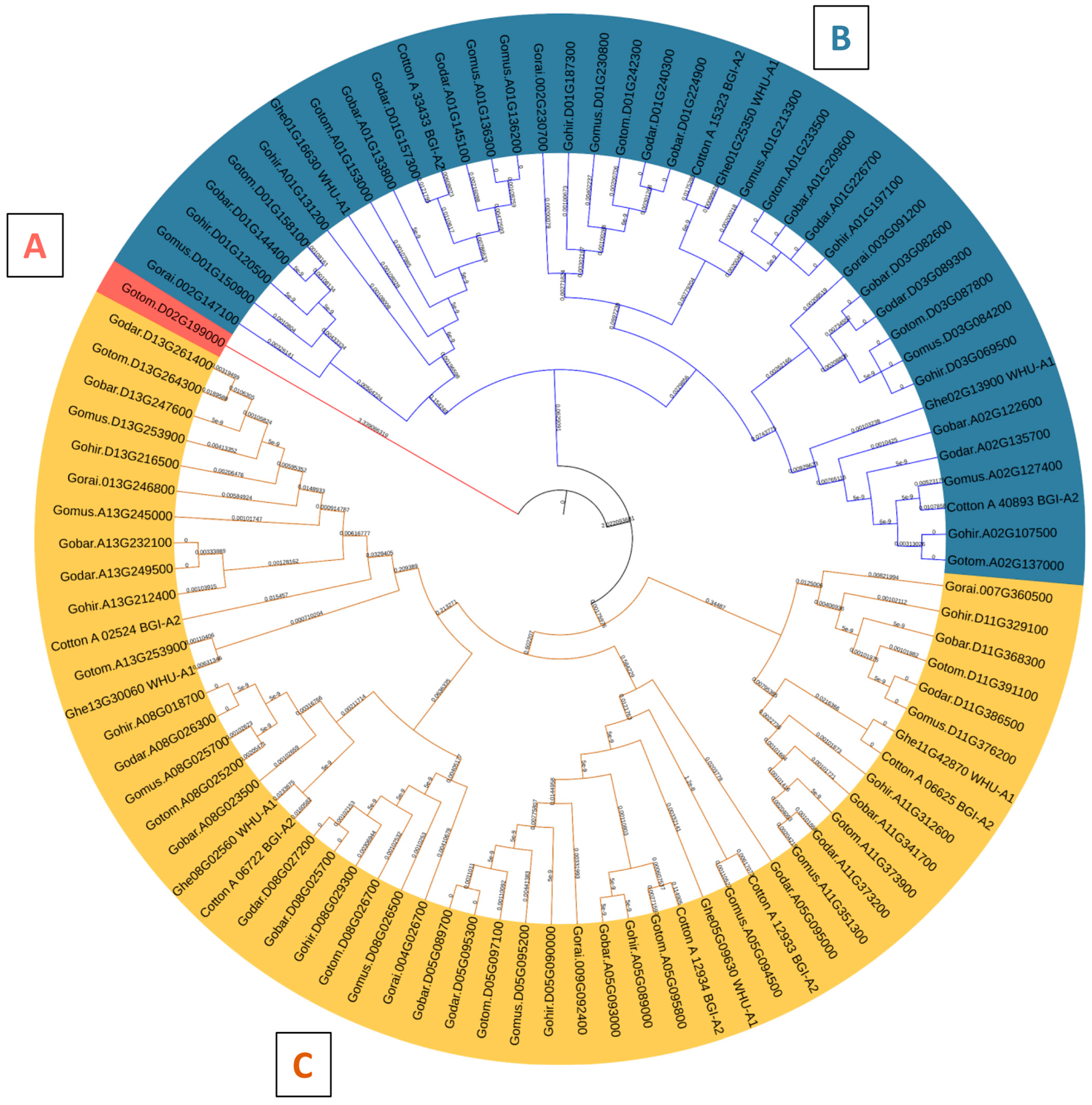

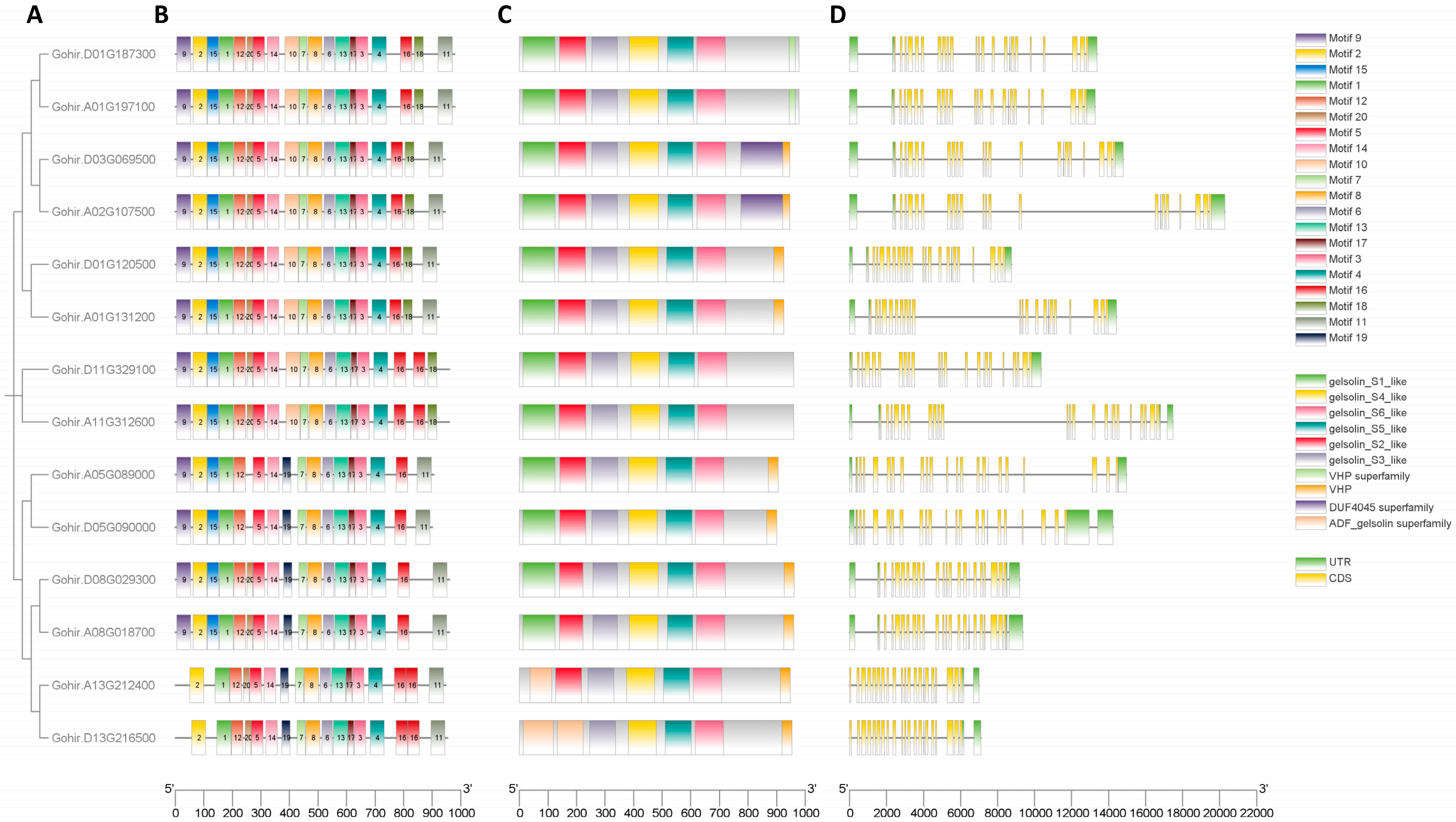

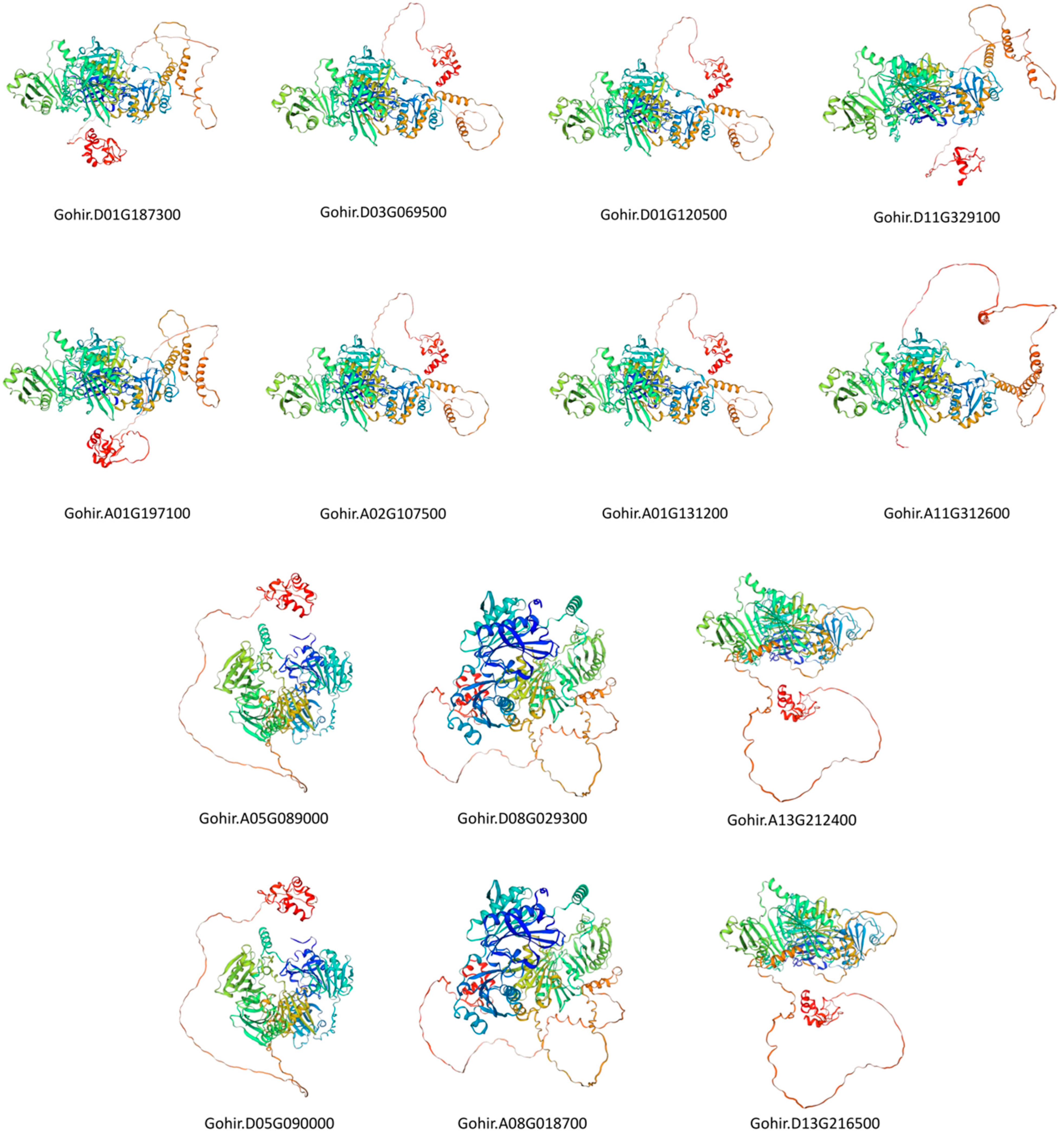


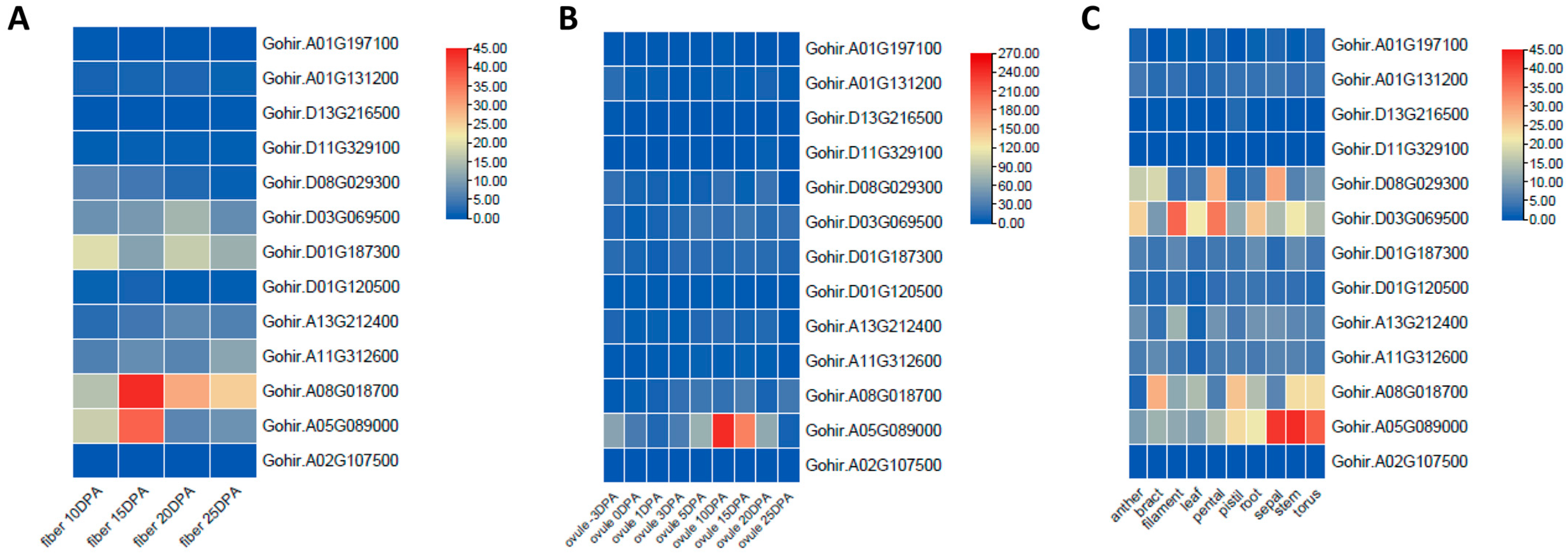

| Motif | Motif Sequences | Length (A.A) | Domain |
|---|---|---|---|
| 1 | VPFARSSLNHDDVFILDTQNKIYQFNGANSNIQERAKALEVVQFJKEKYH | 50 | ADF_gelsolin super family |
| 2 | YDIHFWJGKDTSQDEAGAAAIKTVELDAVLGGRAVQHRELQGHESDKFLS | 50 | ADF_gelsolin super family |
| 3 | FKVEEVYNFSQDDLLTEDILILDTHAEVFVWVGQCVDTKEK | 41 | ADF_gelsolin super family |
| 4 | SLEGLSPEVPJYKVTEGNEPCFFTTFFSWDSTKATVHGNSFQKKLALLFG | 50 | ADF_gelsolin super family |
| 5 | KGLLENNKCYLLDCGAEVFVWVGRNTQVEERKAASQAAEDF | 41 | ADF_gelsolin super family |
| 6 | LFRISGTSPHNMKAJQVDAVATSLNSSECFJLQSGSS | 37 | ADF_gelsolin super family |
| 7 | DYFLCCWIGKDSIEEDQKTAVRLANKMVN | 29 | Not identified |
| 8 | KGRPVQGRVFEGKEPPQFIAJFQPMVVLKGGLSAGYKKSIAEKGJTDETY | 50 | ADF_gelsolin super family |
| 9 | KVLDPAFQGAGQKPGTEIWRIENFQPVPLPKSDYGKFYMGDSYIVLQTTP | 50 | ADF_gelsolin super family |
| 10 | PPLLEGGGKMEVWCINGSAKTPLPKEDIGKFYSGDCYIVLYTYHSGERKE | 50 | ADF_gelsolin super family |
| 11 | YERLKASSTBPVTGIDVKRREAYLSDEEFKEKFGMEKEAFYKLPKWKQBK | 50 | Villin-headpiece domain |
| 12 | GTCEVAIVEDGKLDTESDSGEFWVLFGGFAPJPKKTASEDD | 41 | Not identified |
| 13 | WHGNQSTYEQQQLVARVAEFJKPGVQLKHAKEGSESNAFWSALGGKTEYT | 50 | ADF_gelsolin super family |
| 14 | RITRVIZGYETNSFKSKFDSWPQGSNAPGGEEGRGKVAALL | 41 | Not identified |
| 15 | YFKPCIIPLEGGVASGFKKPEEEEFETRLYVCRGKRVVKLK | 41 | Not identified |
| 16 | GPRQRAPALAALASAFNPSSASKTSAPKPVSRKQGSQRAAA | 41 | Not identified |
| 17 | EKESSEIVRDPHLFTFSFNKG | 21 | Not identified |
| 18 | TAEKKKQSPDGSPIKSTSSTPAVTSPPTEAKS | 32 | Not identified |
| 19 | KEEPQPYIDCTGNLQVWRVNGQEKVLLPA | 29 | ADF_gelsolin super family |
| 20 | TPAKLYSITDGEVKPVEGELS | 21 | Not identified |
| Locus_1 | Locus_2 | Ka | Ks | Ka/Ks | Time (MYA) | Synteny | Selection |
|---|---|---|---|---|---|---|---|
| Gohir.D01G187300 | Gohir.A01G197100 | 0.006674869 | 0.028485622 | 0.234324135 | 1.56514409 | D01/A01 | Purifying |
| Gohir.D03G069500 | Gohir.A02G107500 | 0.008274678 | 0.054163656 | 0.152771775 | 2.976025047 | D03/A02 | Purifying |
| Gohir.D01G120500 | Gohir.A01G131200 | 0.005862153 | 0.046331088 | 0.126527414 | 2.545664167 | D01/A01 | Purifying |
| Gohir.D11G329100 | Gohir.A11G312600 | 0.013325515 | 0.043621315 | 0.305481738 | 2.396775561 | D11/A11 | Purifying |
| Gohir.A05G089000 | Gohir.D05G090000 | 0.010134474 | 0.03314541 | 0.305757995 | 1.821176385 | A05/D05 | Purifying |
| Gohir.D08G029300 | Gohir.A08G018700 | 0.004066581 | 0.042012538 | 0.096794467 | 2.308381209 | D08/A08 | Purifying |
| Gohir.A13G212400 | Gohir.D13G216500 | 0.011020325 | 0.057520859 | 0.191588331 | 3.160486746 | A13/D13 | Purifying |
Disclaimer/Publisher’s Note: The statements, opinions and data contained in all publications are solely those of the individual author(s) and contributor(s) and not of MDPI and/or the editor(s). MDPI and/or the editor(s) disclaim responsibility for any injury to people or property resulting from any ideas, methods, instructions or products referred to in the content. |
© 2024 by the authors. Licensee MDPI, Basel, Switzerland. This article is an open access article distributed under the terms and conditions of the Creative Commons Attribution (CC BY) license (https://creativecommons.org/licenses/by/4.0/).
Share and Cite
Deep, A.; Pandey, D.K. Genome-Wide Analysis of VILLIN Gene Family Associated with Stress Responses in Cotton (Gossypium spp.). Curr. Issues Mol. Biol. 2024, 46, 2278-2300. https://doi.org/10.3390/cimb46030146
Deep A, Pandey DK. Genome-Wide Analysis of VILLIN Gene Family Associated with Stress Responses in Cotton (Gossypium spp.). Current Issues in Molecular Biology. 2024; 46(3):2278-2300. https://doi.org/10.3390/cimb46030146
Chicago/Turabian StyleDeep, Akash, and Dhananjay K. Pandey. 2024. "Genome-Wide Analysis of VILLIN Gene Family Associated with Stress Responses in Cotton (Gossypium spp.)" Current Issues in Molecular Biology 46, no. 3: 2278-2300. https://doi.org/10.3390/cimb46030146







